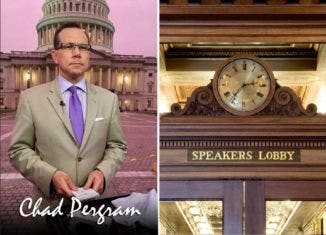Death Panel
The Speaker’s Lobby: Death Panel
By: Chad Pergram, FOX News
30 October 2009
It’s the time of year when Halloween thrill-seekers stalk graveyards in search of goblins and phantasms.
I stalked a cemetery too, this week. For creatures even scarier than ghosts and ghouls.
I was looking for politicians.
Congressional Cemetery in Washington, DC was Arlington National Cemetery long before Arlington National Cemetery ever existed. It’s the final resting place for 19 senators and 71 U.S. representatives. They’re joined by a vice president, a world-renowned band leader, a legendary FBI director, an attorney general, the first woman to seek the presidency and a man who was the original Washington insider. And that’s to say nothing of the dozens of markers memorializing America’s deceased political elite.
Tourists may flock to Arlington National Cemetery to spy the graves of the Kennedys and watch the changing of the guard at the Tomb of the Unknowns. But few journey to the banks of the Anacostia River to pay their respects to America’s first leaders at Congressional Cemetery.
“Every city has old cemeteries,” said Congressional Cemetery Board Chairman Patrick Crowley. “But this cemetery honors the founders of the nation.”
I asked Crowley what the qualifications were for interment. There’s just one.
“Death,” he said.
A good place to start a visit is the cemetery’s public vault. The public vault was essentially a placeholder until the dead could be moved to a permanent grave. The bodies of three presidents dwelled here right after they died: John Quincy Adams, William Henry Harrison and Zachary Taylor. Despite an icy rain, Harrison delivered the longest inauguration address in American history. It ran nearly 8,500 words. The president contracted pneumonia and died a month later. It was the shortest tenure of any U.S. president. Harrison’s family then moved the president’s body to the public vault at Congressional Cemetery until they were ready to bury him in North Bend, OH, a suburb of Cincinnati.
“He spent a month in the White House and three months in here,” said Crowley of Harrison’s stay in the public vault of Congressional Cemetery.
In fact, the remains of Dolley Madison were also interred in the public vault for a time because she died a pauper.
There are numerous monuments that honor lawmakers who aren’t buried at Congressional cemetery. These memorials are known as “cenotaphs,” which technically means “empty tomb.” Each cenotaph is comprised of a squat, sandstone box, topped with a sloped cone. The conical top is reminiscent of the original Capitol Dome. Some of the cenotaphs mark the lives of lawmakers ranging from former House Speaker Henry Clay to former House Majority Leader Hale Boggs (D-LA).
The Boggs cenotaph is intriguing because it’s shared with the man who perished with him in a 1972 plane crash, Rep. Nick Begich (D-AK). Boggs is the father of journalism legend Cokie Roberts. Begich is dad to Sen. Mark Begich (D-AK) who defeated former Sen. Ted Stevens (R-AK) last year. Neither plane nor bodies have ever been found.
Current Rep. Don Young (R-AK) then succeeded the elder Begich in the House. After the Senate swore-in the younger Begich earlier this year, the newly-minted senator made a pilgrimage to his father’s marker at Congressional Cemetery.
Former House Speaker Tip O’Neill (D-MA) isn’t buried at Congressional Cemetery. But his cenotaph is located just steps from the Boggs-Begich monument. It’s a low-cut slab that resembles a contemporary gravestone. Crowley says the Boggs-Begich cenotaph so impressed O’Neill that he wanted one too.
“By far, he’s one of the most prominent, most powerful politicians here,” Crowley said. “Or not here rather.”
There’s a cluster of gravesites wedged together near the north fence of the cemetery: Roland Mahoney. John Smilie. John Dawson. Elijah Brigham. Richard Stanford. Warren J. Coffin (good name for a guy in a graveyard). And Vice President Elbridge Gerry. Gerry was James Madison’s second vice president and one of the co-signers of the Declaration of Independence.
Gerry’s grave stands tall above the others, while a few of the neighboring graves are squished together. Only an inch or two of space separates those gravesites.
This unique layout is only appropriate. After all, Elbridge Gerry gave us the term “gerrymandering.” That’s the practice of drawing the lines of Congressional districts to favor one candidate or another. Gerry was known for crafting bizarrely, misshapen districts. One even resembled a salamander. Journalists soon merged Gerry’s surname and the word salamander to coin a new phrase that’s become part of the American lexicon.
Perhaps the most-visited grave in Congressional Cemetery belongs to longtime FBI Director J. Edgar Hoover. Hoover led the FBI for 35 years. And his grave is just as striking as his career. It’s lined with a wrought-iron fence, bearing the FBI seal. Even a little bench emblazoned with the FBI logo sits near Hoover’s tomb.
Down the row from Hoover’s grave is a marker bearing the name Clyde Tolson. Students of history will note it’s no accident that only a few yards separate the final resting places of both men. Hoover plucked Tolson from the FBI rank-and-file to be his number two. The men socialized together and took most meals together. They were inseparable. In life. And in death.
Yet the sandstone inscriptions on neither the Hoover nor Tolson grave alludes to the other man.
Another unique grave lays down the same row from Tolson’s.
The marble on Leonard Matlovich’s tombstone is deep charcoal. The inscription reads “A Gay Vietnam Veteran.” It features a relief of Bronze Star citation President George HW Bush presented to Matlovich. And then there are these words at the bottom of the stone: “When I was in the military, they gave me a medal for killing two men and a discharge for loving one.”
Patrick Crowley says Matlovich’s marker “is probably the strongest political statement” in the cemetery. Crowley notes that a lot of gay and lesbian groups visit Matlovich’s gravesite. He says one visitor who knew Matlovich said that “his life was really about the political statement he was making.”
Obscure but important figures also lie at Congressional Cemetery.
Historians debate about whether Belva Lockwood is either the first or second female to seek the White House. Most historians argue the first female presidential candidate was Victoria Woodhull in 1872. But her name was never printed on any ballots and she didn’t meet the Constitutional requirement of 35 years of age. But one thing is certain: Belva Lockwood is buried at Congressional Cemetery. She sought the presidency in 1884 and 1888. People voted for her. She even implored Congress to count her ballots. It didn’t. Lockwood died in 1917.
Washington is known for it’s “insiders.” There’s lobbyist Tony Podesta. The Washington Post’s Bob Woodward. Attorney Vernon Jordan. And White House Chief of Staff Rahm Emanuel.
But well before there were Messrs. Podesta, Woodward, Jordan and Emanuel, there was Tobias Lear.
Patrick Crowley says Washington, DC is a town of “who you know and who you work for.” And in his day, Tobias Lear worked for the best. He was personal secretary to President George Washington.
You can barely read the top of Lear’s tombstone today. But Crowley calls Lear was “the original Washington insider.”
A Fourth of July celebration is not complete without a rousing rendition of John Phillip Sousa’s “Stars and Stripes Forever.” And a visit to Congressional Cemetery isn’t complete without stopping by the grave of the man known as “The March King.” In fact, Crowley describes Sousa as “the best-known musician around the world of his time.”
Sousa led the U.S. Marine Band served as conductor of The President’s Own band for administrations ranging from Rutherford B. Hayes to Benjamin Harrison. He also composed “Semper Fidelis” and “The Washington Post.”
Crowley says high school marching bands play a tribute to Sousa at the cemetery.
Located at the base of Sousa’s grave is a G clef, accompanied by a musical score cut into the sandstone. Translate the notes and sharps correctly, and you can whistle the opening bars to Sousa’s magnum opus “Stars and Stripes Forever.”
“A man of great stature deserves a great monument,” says Crowley.
Great men and monuments aside, it is Halloween. And Congressional Cemetery is noted for tales of the macabre.
One of the mostly grisly stories involves Arctic explorer William Cross. He was one of 19 men who died during an 1881 expedition to the North Pole. Cross froze starved to death. And Cross is buried at Congressional Cemetery. But with a caveat.
“Some of him rests here,” says Crowley.
Crowley says when rescue boats finally packed up the dead, undertakers noticed that Cross’s body looked like it had been butchered.
“His friends had him over for lunch,” says Crowley of the desperate explorers who barely survived the mission.
Robert Slight is buried at Congressional Cemetery. He was a carpenter who fell from the Capitol Rotunda one night. Legend has it that Slight’s ghost inhabits the Rotunda, often toting a wooden tray of tools.
Of course, besides Slight, the Capitol itself boasts a roster of characters who haunt the building. The ghost of John Quincy Adams is spotted periodically in Statuary Hall. A “demon” cat is said to prowl the Capitol just before national tragedies like the Lincoln and Kennedy Assassinations and 9-11.
But this Halloween, be on the lookout for a very special ghost.
On Thursday, House Speaker Nancy Pelosi (D-CA) unveiled the final version of the massive health care reform bill. All told, the legislation runs 1,990 pages.
“This huge bill is designed to be so complex that nobody would ever know for sure what’s in it,” sighed House Minority Leader John Boehner (R-OH).
But Boehner didn’t count on the apparition of a legislator from another era.
Steve Livengood of the U.S. Capitol Historical Society says the late Sen. Boies Penrose (R-PA) “liked to take pride in reading every bill that was on the floor.”
Penrose served 24 years in the Senate, dying in 1921. He was a bachelor and would often stay late at the Capitol, reading the bills as he rocked in a creaky rocking chair.
Livengood says you could hear the squeaking of the rocking chair all over the Senate wing of the Capitol.
“He died in office. Nobody told him,” Livengood. “And you can still hear him.”
Lots of lawmakers will cull through the health care reform bill this Halloween weekend. However, few if any will read all 1,990 pages.
But if you hear a mysterious squeaking emanating from the Senate, it may be the ghost of Sen. Penrose. He’s just sifting through the vagaries of “COBRA extensions” and “negotiated rates” for doctors.
- Chad Pergram covers Congress for FOX News. He’s won an Edward R. Murrow Award and the Joan Barone Award for his reporting on Capitol Hill.
- The Speaker’s Lobby refers to a long, ornate hallway that runs behind the dais in the House chamber. Lawmakers, aides and journalists often confer there during votes.

